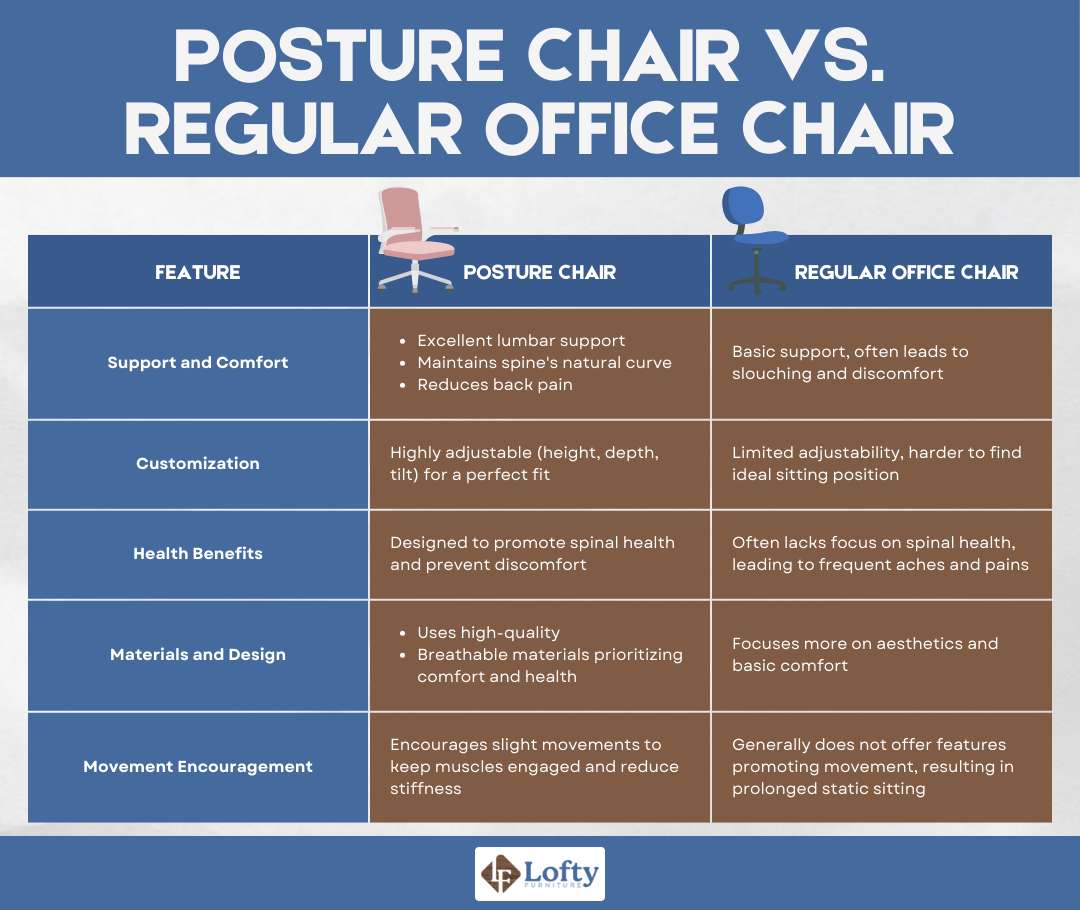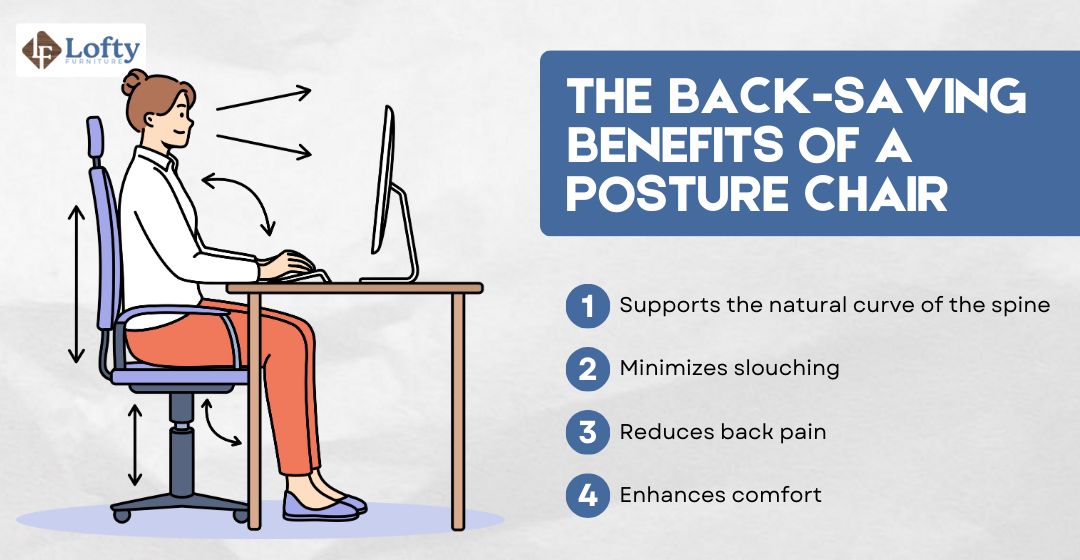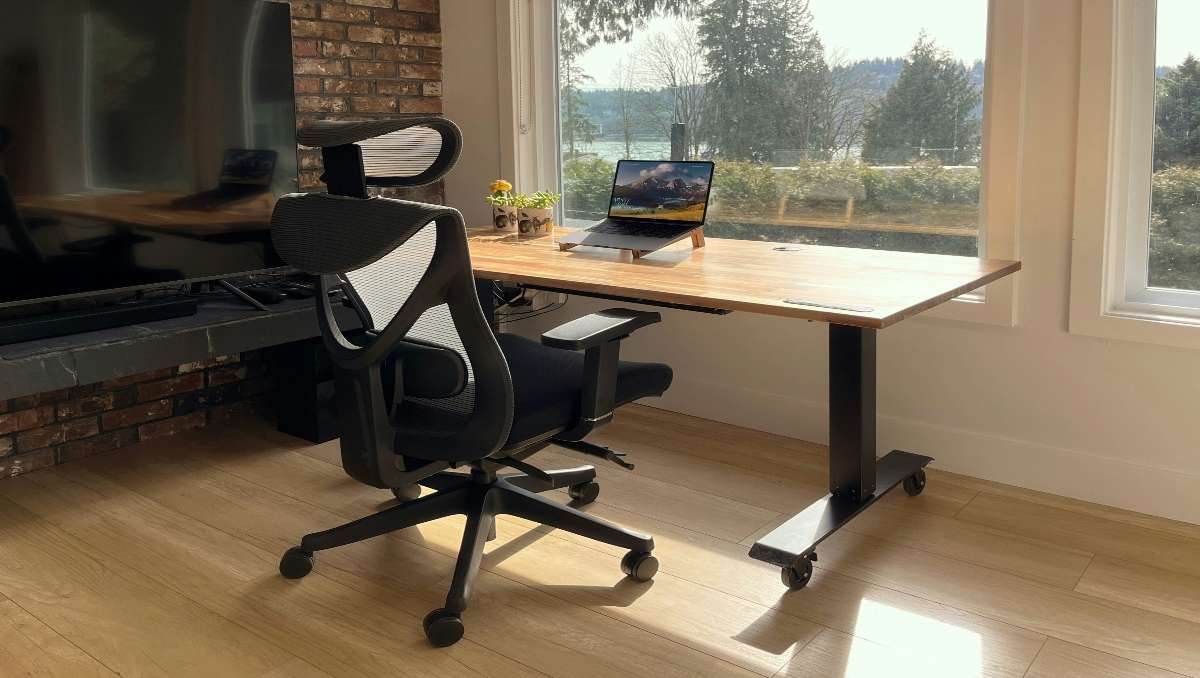Sitting for long periods of time can take a serious toll on your back, often leading to discomfort and poor posture. The impact of an ill-fitting chair is more than just an inconvenience—it can contribute to chronic pain and long-term health issues. On the other hand, choosing the right chair can be a game changer for your spine and overall well-being. A well-designed chair provides the support your body needs, helping to alleviate pain and improve posture.
Key Takeaways
- Posture chairs are specifically designed to support the natural curve of your spine, which helps reduce back pain and prevent slouching.
- Posture chairs offer extensive adjustability in height, depth, and tilt, allowing you to customize the chair to fit your body perfectly, unlike regular office chairs which often lack these features.
- By enhancing comfort and supporting healthy sitting habits, posture chairs can increase productivity and contribute to a more comfortable and pain-free daily routine.
This article explores how posture chairs work, their benefits compared to regular office chairs, and tips for maintaining good posture while sitting.
What is a Posture Chair?

A posture chair is a thoughtfully designed chair that helps you sit correctly by offering adjustable ergonomic features. These ergonomic office chairs are great for keeping your spine aligned, reducing back pain, and promoting healthy sitting habits. They are perfect for preventing discomfort and boosting your overall well-being, especially if you spend long hours sitting.
They often incorporate the following features to encourage healthy spinal alignment and reduce strain on your back and neck:
- Lumbar support: A built-in curve in the backrest that cradles your lower back and keeps your spine in a neutral position.
- Contoured seat: A seat that shapes to your curves and helps distribute your weight evenly.
- Adjustable features: The ability to adjust the height, backrest angle, armrests (if present), and sometimes even the seat depth to fit your individual body and needs.
- Ergonomic design: An overall design that prioritizes comfort, support, and proper posture.
How Does It Compare With Regular Office Chairs?
Posture chairs and regular office chairs differ significantly in terms of support, customization, health benefits, materials, and movement encouragement. Posture chairs provide excellent lumbar support, maintaining your spine’s natural curve and reducing the risk of back pain. Regular office chairs, meanwhile, often lack this level of support, leading to slouching and discomfort.
Posture chairs also offer extensive adjustability in height, depth, and tilt, allowing for a perfect fit, while regular office chairs typically have limited adjustability. Designed to promote spinal health and prevent discomfort, posture chairs use high-quality, breathable materials that prioritize comfort and health, unlike regular office chairs that often focus more on aesthetics.
Additionally, posture chairs encourage slight movements throughout the day, keeping your muscles engaged and reducing stiffness. In comparison, regular office chairs generally do not offer this feature, resulting in prolonged static sitting.
For a clearer understanding of how these two types of chairs are different, here’s a more in-depth comparison you can use as a guide:

The Impact of Poor Posture on Your Health
Poor posture may seem like a minor issue, but it can have a significant impact on your overall health. Just picture this:
When you sit with poor posture, you might notice discomfort creeping in quickly. Back pain can start to bother you, as slouching compresses your spine and puts unnecessary pressure on your lower back. This can lead to persistent pain that doesn’t seem to go away. Additionally, poor posture can cause tension in your shoulders and neck, making you feel stiff and often leading to headaches. These immediate discomforts can make it hard to focus and enjoy your day.
The Long-Term Effects of Improper Posture

The consequences of poor posture can become more severe over time. Chronic back and neck pain can develop, making daily activities difficult and painful. Poor posture can also affect your digestion and breathing.
When you slouch, your abdominal organs are compressed, slowing down your digestive process. Similarly, poor posture can restrict lung capacity, leading to shallow breathing and reduced oxygen intake.
A study published in the Journal of Physical Therapy Science found a clear link between poor posture and musculoskeletal pain, particularly in the lower back and neck. Individuals with poor posture are significantly more likely to experience chronic pain compared to those with good posture.
The American Chiropractic Association (ACA) reports that back pain is one of the most common reasons for missed work, with poor posture being a major contributing factor. Approximately 80% of Americans will experience back pain at some point in their lives, and poor posture is a significant risk factor.
Harvard Health research also indicates that poor posture can negatively impact mental health. Their study showed that individuals who practiced good posture felt more energetic and confident, while those with poor posture experienced higher levels of stress and fatigue.
How Can A Posture Chair Transform Your Back
A posture chair promotes proper spinal alignment, which is crucial for maintaining a healthy back. These chairs are equipped with adjustable features that support the natural curve of your spine. The lumbar support they offer ensures that your lower back is well-supported, reducing the risk of slouching and the associated pain.
As Jung Baccam FNP-BC at Atlas Ketamine explains:
“A well-designed chair encourages proper posture, evenly distributing your weight, and helping you avoid slouching. Over time, this can reduce the risk of long-term spinal problems, such as poor posture or disc degeneration.“

Here are other specific benefits you can get from investing in a posture chair:
Enhances Comfort: Posture chairs use high-quality, breathable materials that prioritize comfort and health. The cushioning and ergonomic design help distribute your weight evenly, reducing pressure points and discomfort.
Increases Productivity: Sitting comfortably with proper support can lead to increased productivity. When you’re not distracted by pain or discomfort, you can focus better on your tasks.
Encourages Movement: Many posture chairs are designed to allow and encourage slight movements throughout the day. This can help keep your muscles engaged and reduce stiffness, which is often caused by prolonged static sitting.
What to Look for in A Posture Chair
Selecting a posture chair with the right features can significantly enhance your comfort and well-being. Here are the most important features you should prioritize:

Ergonomic Design
An ergonomic design is paramount for maintaining proper posture and preventing discomfort.
Jung Baccam added:
“Chairs with proper lumbar support help maintain your spine’s natural curve, which reduces strain on your lower back. This can prevent or ease conditions like chronic back pain and herniated discs.”
Adjustable Seat Height
An adjustable seat height feature allows you to align your chair with your desk or workspace. This ensures that your feet rest flat on the floor, promoting better circulation and reducing strain on your legs. Proper alignment can also help prevent fatigue and improve overall comfort.
Adjustable Backrest
A chair with an adjustable backrest allows you to customize the angle and height to fit your spine’s natural curvature. This feature is crucial for reducing back pain and providing adequate support during long periods of sitting. Being able to recline slightly can also relieve pressure on your lower back.
Breathable Material
Choosing a chair made from breathable materials, such as mesh, can significantly enhance comfort. Breathable materials allow air circulation, preventing sweating and discomfort, especially during warmer months or extended use. This feature helps regulate body temperature and keeps you cool and comfortable.
Seat Depth Adjustment
Seat depth adjustment is essential for ensuring that the chair supports your thighs without putting pressure on the back of your knees. This feature allows you to customize the seat depth to match your leg length, promoting proper blood flow and reducing the risk of discomfort or circulation issues.
Tips for Maintaining Good Posture While Sitting
Taking care of your back isn’t just about finding the right chair; it’s also about being mindful of the way you sit. Here are some tips to help you maintain proper posture when sitting:

Sit All the Way Back in Your Chair: Make sure your back is fully supported by the backrest of your chair. This helps maintain the natural curve of your spine.
Adjust Your Chair Height: Make sure your feet rest flat on the floor and your knees are at a 90-degree angle. This helps distribute your weight evenly and reduces pressure on your thighs and lower back.
Use Lumbar Support: If your chair doesn’t have built-in lumbar support, use a small pillow or a rolled-up towel to support your lower back. Proper lumbar support is crucial for maintaining the natural curve of your spine.
Keep Your Computer Screen at Eye Level: Position your computer screen at eye level to avoid leaning forward or tilting your head up or down. This helps reduce strain on your neck and shoulders.
Keep Your Shoulders Relaxed: Keep them down and not hunched up towards your ears. This helps reduce tension in your neck and shoulders.
Take Frequent Breaks: Stand up and move around every 30 minutes to an hour. This helps reduce stiffness and promotes better circulation.
You might be interested in reading about an ADHD chair designed for focus and comfort.
Conclusion
Choosing the right chair, such as a posture chair, can make a significant difference in your overall health and well-being. By supporting proper spinal alignment, reducing back pain, and promoting healthier sitting habits, posture chairs are a valuable investment for anyone spending long hours at a desk. They offer superior adjustability, comfort, and health benefits compared to regular office chairs. Making the switch to a posture chair can transform your back health, enhance your productivity, and contribute to a more comfortable and pain-free daily routine.
FAQs
Do ergonomic chairs fix posture?
Ergonomic chairs can significantly improve posture by providing adjustable features that support the natural curves of your spine, thereby reducing strain and discomfort. However, simply using an ergonomic chair is not enough; it must be properly adjusted to fit your body and you need to maintain awareness of your sitting habits to achieve optimal posture.
How do I know if my chair is good for my posture?
A chair is good for your posture if it has adjustable height, seat depth, and lumbar support, allowing you to maintain a 90-degree angle at your knees and hips with your feet flat on the floor. Additionally, you should feel supported without any pressure points, and your back should rest comfortably against the backrest, maintaining the natural curve of your spine.
Are hard chairs better for posture?
Hard chairs are not necessarily better for posture; the key is whether the chair provides proper support and encourages a neutral spine position. While hard chairs can prevent slouching, they often lack the ergonomic features needed to adjust for comfort and support, which can lead to discomfort and poor posture over time.
